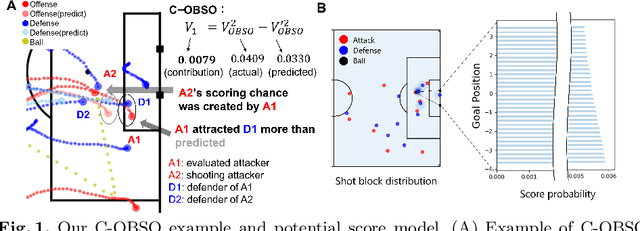Masakiyo Teranishi
Evaluation of creating scoring opportunities for teammates in soccer via trajectory prediction
Jun 04, 2022



Abstract:Evaluating the individual movements for teammates in soccer players is crucial for assessing teamwork, scouting, and fan engagement. It has been said that players in a 90-min game do not have the ball for about 87 minutes on average. However, it has remained difficult to evaluate an attacking player without receiving the ball, and to reveal how movement contributes to the creation of scoring opportunities for teammates. In this paper, we evaluate players who create off-ball scoring opportunities by comparing actual movements with the reference movements generated via trajectory prediction. First, we predict the trajectories of players using a graph variational recurrent neural network that can accurately model the relationship between players and predict the long-term trajectory. Next, based on the difference in the modified off-ball evaluation index between the actual and the predicted trajectory as a reference, we evaluate how the actual movement contributes to scoring opportunity compared to the predicted movement. For verification, we examined the relationship with the annual salary, the goals, and the rating in the game by experts for all games of a team in a professional soccer league in a year. The results show that the annual salary and the proposed indicator correlated significantly, which could not be explained by the existing indicators and goals. Our results suggest the effectiveness of the proposed method as an indicator for a player without the ball to create a scoring chance for teammates.
Evaluation of soccer team defense based on prediction models of ball recovery and being attacked
Mar 19, 2021



Abstract:With the development of measurement technology, data on the movements of actual games in various sports are available and are expected to be used for planning and evaluating the tactics and strategy. In particular, defense in team sports is generally difficult to be evaluated because of the lack of statistical data. Conventional evaluation methods based on predictions of scores are considered unreliable and predict rare events throughout the entire game, and it is difficult to evaluate various plays leading up to a score. On the other hand, evaluation methods based on certain plays that lead to scoring and dominant regions are sometimes unsuitable to evaluate the performance (e.g., goals scored) of players and teams. In this study, we propose a method to evaluate team defense from a comprehensive perspective related to team performance based on the prediction of ball recovery and being attacked, which occur more frequently than goals, using player actions and positional data of all players and the ball. Using data from 45 soccer matches, we examined the relationship between the proposed index and team performance in actual matches and throughout a season. Results show that the proposed classifiers more accurately predicted the true events than the existing classifiers which were based on rare events (i.e., goals). Also, the proposed index had a moderate correlation with the long-term outcomes of the season. These results suggest that the proposed index might be a more reliable indicator rather than winning or losing with the inclusion of accidental factors.
 Add to Chrome
Add to Chrome Add to Firefox
Add to Firefox Add to Edge
Add to Edge